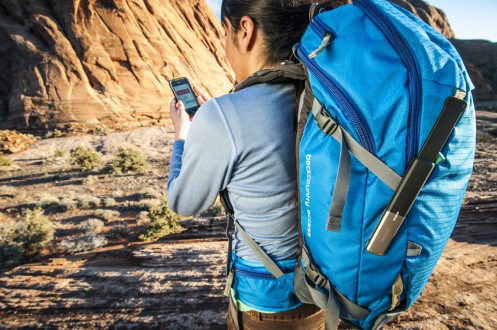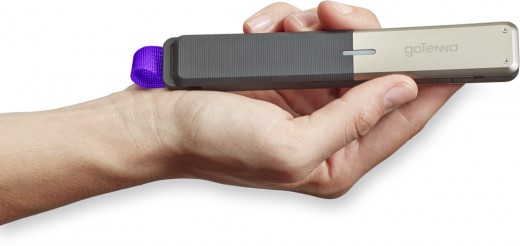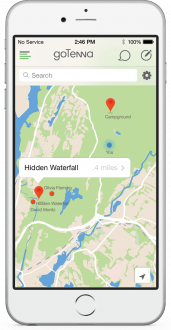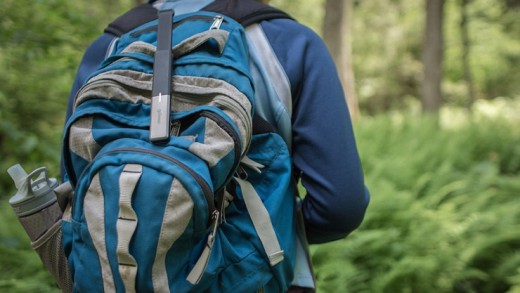- Rangers, hikers, and researchers all need to communicate in the field, though mobile coverage is poor or absent in many remote areas.
- The goTenna device connects via Bluetooth to a smartphone, and via long-range radio to one or more other goTennas to provide instantaneous SMS communication between the devices.
- Still on pre-order, goTenna tests indicate local (2-6 km) communication in forest and a longer range if devices can be elevated.
A ranger contacts his team through the dense forest to ask for backup support in investigating a recently poached animal. A research team calls its base camp to ask for help with an injured colleague. Regular communication can improve nearly every aspect of field-based work, yet the need for communication often wildly exceeds its availability in remote areas.
Your team may soon be able to take their communication network with them to the field. The tech world has been abuzz since the team at goTenna rolled out a prototype in July 2014 for a portable antenna that creates a private, encrypted radio-frequency (RF) network for your smartphone through a wireless Bluetooth connection.

Although radio signals (High, Very-High, and Ultra-High Frequency) have enabled long-range communication for decades (for radio and TV, for example), mobile phones don’t access radio signals. Connected to a smartphone, the goTenna allow SMS communication via transmission and reception of radio signals, independent of wifi and cellular coverage.
This innovative and easy-to-use product has won multiple awards, including an Editor’s Choice award at a recent International Consumer Electronics Show in Las Vegas.
The 2 oz., 6-inch (15-cm, 53-gram) antenna uses a Very-High Frequency (VHF) radio that provides a low level of bandwidth whichallows the transfer of text messages and GPS coordinates (but not voice) between goTenna units over distances of up to 9 miles (14km) in ideal conditions, such as flat, open terrain. In tests, the rechargeable battery lasts for 24 hours of continuous use on one charge. It also confirms delivery of a message, so you know you’ve made contact. The accompanying phone app comes with high-definition, downloadable maps to plot coordinates, allowing you to see where others on your network are located.

The publicized applications of this technology range from allowing users to stay in contact with friends where cell networks are overloaded, such as at sports games and music festivals, to helping adventurers to stay safe and together while in the wilderness and remote areas where networks do not exist. However, no one has examined its potential utility for conservation.

Like hikers and other adventurers, rangers and forest managers on the front lines of conservation often operate in parts of the world where reliable communication networks are hard to find. Each goTenna generates its own signal, allowing the owner to communicate with other goTenna-connected smartphones. To use the system, each phone must be connected to its own goTenna, making it most beneficial for teams working together.
Some argue that the existence of cell networks could do more harm than good, allowing poachers to communicate and operate more effectively in protected areas. goTenna could address these problems, enabling field staff to communicate over long distances, an estimated 1-4 miles (1-6 km) in forests, on an encrypted network while sharing location data in real time. The signal encryption would be attractive to both researchers and protected area managers, many of whom worry about poachers tapping into unsecured tracking systems. A team can specify which groups or individuals can receive messages, further securing the communication.
The antenna’s lightweight, weather-proof, dust-proof package and its compatibility with smartphone technology may, in time, allow it to integrate into a low-cost animal tracking device, with some modifications for battery life.
Although the transmit distance is still shorter than most people would desire, it increases with elevation. Increasing your elevation by just 50 feet could more than triple the theoretical range of one unit to about 11 miles. A single goTenna with this increased range could act as a backbone node in a wireless mesh network of these devices dispatched to rangers and animals alike.

The long battery life, encryption, and “pre-order” $150 price tag for a pack of two antennas make this technology a communications aid with potential to be both affordable and practical for many parks and reserves worldwide.
Since the device is still on pre-order, we welcome reactions and assessments from those that use it in the field, and we look forward to seeing the potential applications of this technology.
Requirements:
- Operating System: iOS7 or above or Android 4.3 or above, Bluetooth-LE enabled smartphone (works with tablets but display is best on small devices) within 20 ft (7m) of the goTenna
- Devices: Communication possibly only with a smartphone and only via other goTenna-connected smartphones that are within range (i.e. not with a base station or HQ, unless it also has a goTenna and is within range)
